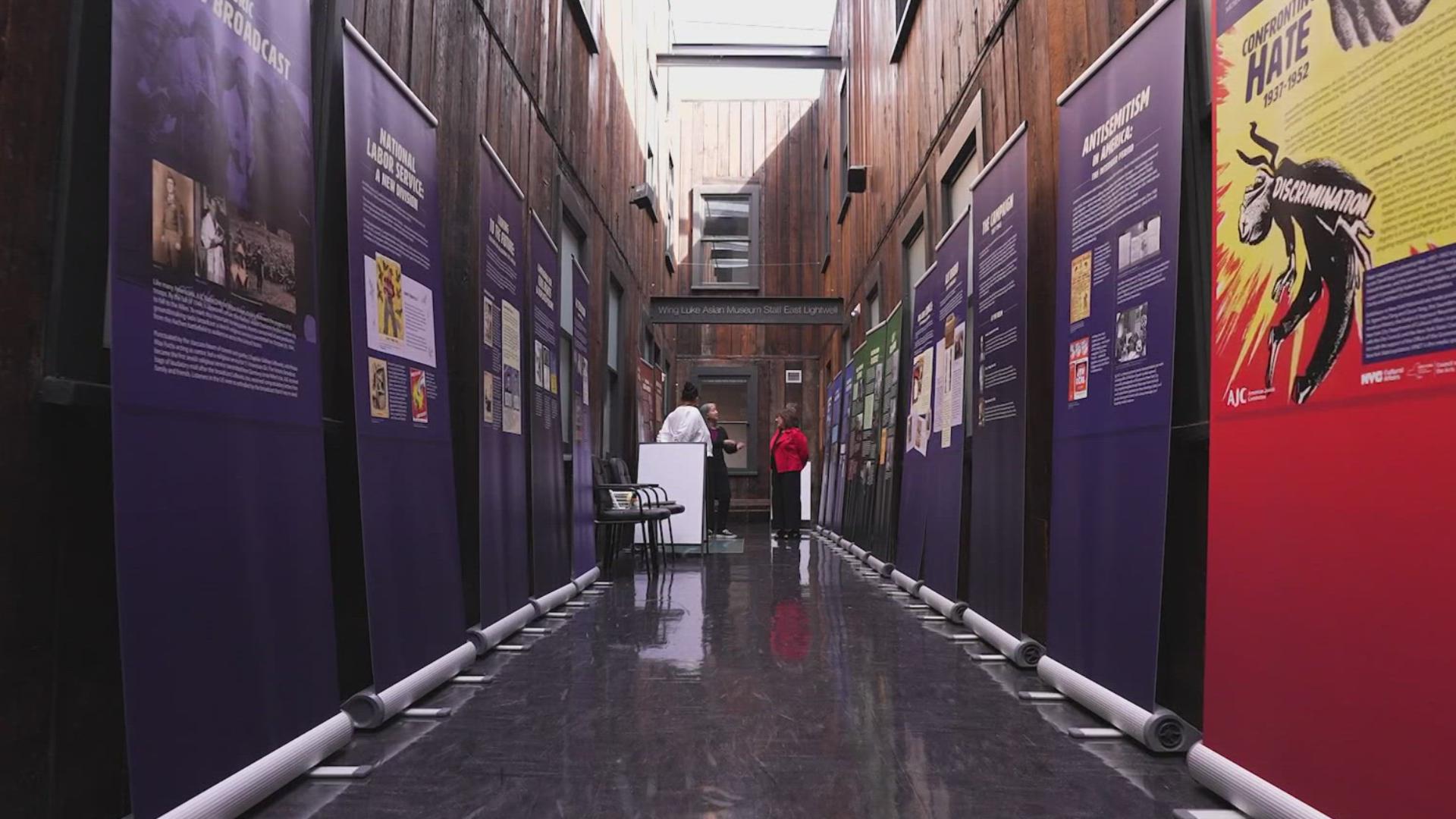SEATTLE — Seattle's Wing Luke Museum is hosting a new exhibit in an effort to tackle hate on a local level.
"Confronting Hate Together," which opens at the museum Wednesday and ends June 30, is not just a poster collection. It's a call to action in the face of division.
Now the three women responsible for bringing the exhibit to life went on the record with KING 5's Joyce Taylor.
What the exhibit shows
Cassie Chinn, Wing Luke Museum deputy executive director: There's a great photo that shows the Jackson Street Community Council (in the) 1950s - people across all different ethnic backgrounds coming together to organize.
Stephanie Johnson-Toliver, Black Heritage Society of Washington State president: The photos. I love the images on the panels.
Chinn: Images of people together taking action (and) protest against housing segregation."
Lisa Kranseler, Washington State Jewish Historical Society executive director: Each of us in our community panels took the initial history of the past and of the present and thought of ways for the future, that we could come together.
Johnson-Toliver: And the fact that there's some messaging there for young people.
Kranseler: And we feel it's just the beginning of the conversation.
Taylor: Is there a moment that you remember the very first time you realized that your race mattered?
Johnson-Toliver: I'm a fourth-generation Seattleite. I grew up in the 50s and into the 60s. And so I never had a teacher that looked like me. Until I was, well, I'd say probably even sixth grade.
Chinn: I too am fourth generation - Chinese American here in Seattle. I grew up in Beacon Hill in the 70s. I remember the first time I experienced a racial slur was in kindergarten.
Taylor: What about you Lisa?
Kranseler: I grew up north of New York City. And in a community that was probably about 50% Jewish but then I moved to Boston and worked for what was then a big aid accounting firm. Ant was my first few weeks there, and Rosh Hashanah and Yom Kippur were coming. And there were no holidays off. And so it was a bit of a culture shock for me.
How the exhibit came together
Taylor: Tell me, Lisa, tell me about this project. It's ambitious and why now?
Kranseler: The project really started about a year and a half ago for me when I first saw the exhibit at the New York Historical Society. And it was confronting hate. It was an original poster show. And it really spoke to me. It was against all forms of hate. And I thought, 'Let's bring this back to Seattle.'
Taylor: So you came back to Seattle with this idea, looking for partners. And we bring in Cassie and Stephanie. So when she came to you that we need a museum. Cassie, why did you say yes to this project?
Chinn: The decision was easy, in a sense, because our three communities grew up together side by side in Seattle, and especially in the Central District. So when Lisa came and suggested this idea it seemed natural to step into stewarding that legacy, of togetherness, of community building of being there for one another.
Recent events
Taylor: Stephanie, it's not lost on me that it's four years from the incident that happened with George Floyd, yes, this exhibit is going to open. So why did you want to?
Johnson-Toliver: I was really intrigued by the original exhibit, and the inspiration of that and bringing it to Seattle, and how relevant all of that is today, where, you know, we're still struggling with all of those harms against people.
Taylor: Let's talk about the importance then of showing solidarity. Why is that important, especially now, because I think post COVID, (and) the rise in Asian hate, why is now a really important time to show solidarity?
Kranseler: It's critical to stand together. We were there for each other when the synagogue was defaced. And when, when the Wing Luke building, the windows were destroyed, we were there. It shows the unity that we will not stand for hate in our community.
Taylor: In this very complicated landscape with the Israel-Hamas war and the increase of protests, especially in college campuses across the country. Is there a feeling of understanding or abandonment?
Kranseler: I don't personally feel abandoned, but I can understand that some in the community would say that they do feel that way. But I think that overall, we're getting a lot of support and continuous support.
Chinn: The pressures that we live in fuel division, they fuel this sense of isolation, abandonment. Hate breeds hate. And so it makes sense that people could feel that sense. We're not always going to agree. But you're important to me as a human. And I want to listen to you, I want to connect, I want to understand.
Looking ahead to the future
Johnson-Toliver: In this exhibition, I really hope that people will listen, they'll talk and discuss and find their way to one another, in all of our humanity.
Chinn: We can see the tendency to want to disengage, to just not get involved. By doing that, then what? We're undercutting the impact that we can have. We're undercutting the change that can happen.
Kranseler: It starts from a very young age, and our young people are experiencing difficulties now. And I mean, having that education and togetherness from an early on is really critical.
Johnson-Toliver: If we're making these differences and looking at ourselves individually, and then coming together collectively, I see that as our superpower. That is our power. We find our empathy in that. So if people can find their way to empathy, you know, and care and understanding for one another. That's a really hopeful future.

